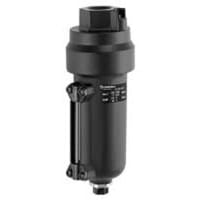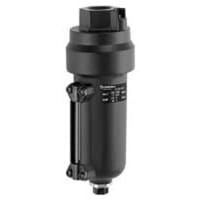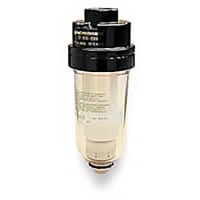

Air Dryers and Drains
We stock a wide range of air dryers and drains for your pneumatic systems to remove water drops and other condensates. Pneumatic air dryers and air drain both perform essential functions in keeping your pneumatic system functioning effectively.
You can find both units in a variety of types and sizes here, ensuring you get the exact equipment you are looking for and feel confident it will perform up to a high standard.
What are air dryers and drains?
Air dryers, also referred to as compressed air dryers or pneumatic air dryers are machines that are used during pneumatic air preparation in both industrial and commercial settings. Their purpose is to remove water vapor from compressed air within pneumatic systems.
Air drains, also known as pneumatic drains and automatic drains, are also key pieces of equipment within pneumatic air preparation. They effectively remove condensates, such as water, which can build up within different parts of your pneumatic system.
Together, they ensure your pneumatic system maintains a steady flow of clean compressed air, free from moisture and oil, and drains those condensates out of the system to minimize the risk of any maintenance issues.
How do air dryers work?
Compressed air dryers are designed to separate any water vapor or moisture from process air used in industrial or commercial environments.
The unit dehumidifies the air it takes into the system and compresses it. This raises the air temperature, which then requires cooling in order to condense any water vapor and remove it.
There are three main types of air dryer which are used to do this.
Refrigerated air dryers
This is a common air dryer that is used due to easy maintenance and cost-effective operation. Refrigerated air dryers work by rapidly cooling the compressed air, condensing it, and then draining out the moisture.
Cycling dryers perform this process by maintaining the dew point at a constant temperature, while non-cycling dryers shut down and restart at intervals to maintain the necessary temperature.
Desiccant air dryers
Desiccant air dryer systems are typically comprised of two specialized towers – one which dries the air and another which regenerates the desiccant. Within the drying tower, a porous desiccant material is positioned so that the compressed air passed over it.
Desiccant materials are hygroscopic substances, meaning that they absorb water and can be an effective tool for the dehumidification process. There are heated and heatless variations that utilize different methods of expelling moisture build-up.
You can also find single tower desiccant air dryers for use in hazardous or corrosive environments, as they do not require electricity to function or contain any mechanical parts.
Membrane air dryers
Membrane dryers make use of a permeable membrane in order to extract any water vapor from the processed air. This works by passing the water vapor through the membranes within the system to be expelled via purge air, while the clean compressed air is retained and continues through the system unimpeded.
Why are air dryers needed?
Moisture can create many problems for pneumatic systems. It can cause parts to become worn out and corrode faster than expected. You can also need to use more energy in order to maintain the same level of compressed air output.
Eventually, the damage which is caused by the moisture within compressed air can lead to parts breaking down. A central pneumatic compressed air dryer is designed to keep moisture out of your system, extending its life and saving you on maintenance costs.
Benefits of pneumatic air dryers
There are a number of benefits and features which air dryers can have, depending on which type you choose to go with and its design:
- Removing up to 99.9% of water droplets from your system
- Can automatically drain collected water out of the system
- Doesn’t require a power supply, saving you on energy costs
- Are resistant to clogging so your system can run for longer without issue
How do pneumatic drains work?
When moisture and other condensates are formed during the operation of an air preparation system, they will typically need to be collected and expelled by your system at some point.
A pneumatic air compressor drain allows the moisture and contaminants to be automatically removed from your system into a safe containment space. This prevents them from building up and causing damage to your equipment.
Pneumatic drains can be installed at the lowest points within your system to help prevent condensation from collecting and causing issues. You will commonly find a range of pneumatic drains which collect the condensates and expel them automatically. These can be a popular choice as having an air compressor auto drain system removes the risk of forgetting to manually empty, which may cause delay to processes or damage to machinery.
Why are pneumatic drains important?
The purpose of pneumatic drains is to remove condensates and other contaminants from your system in a safe way. They can do this without needing to shut down your system or impacting the efficiency of your air preparation system. Without drains, moisture could remove lubrication from crucial components or cause rust to form in problematic places.
Strategic positioning of pneumatic drains will help your system run smoothly, but you will need to make sure you are using the correct pneumatic drain. Using the wrong type of drain won’t properly remove condensate, can allow compressed air to leak out, or potentially both.
In a similar way to how air dryers remove moisture from your system during the creation of compressed air, pneumatic drains can extend the life of your system by extracting moisture that could otherwise do damage to your equipment.
Benefits of pneumatic air compressor drain
Different types of air drains will have different features but the benefits to your system are relatively universal:
- Improve the longevity of your air preparations system
- Help to prevent rust from forming within the system
- Avoid the need to shut the system down in order to remove condensates
Some air compressor drains can also have additional beneficial aspects to their design:
- Manual test button to ensure the valve is operational
- Ball support and position systems can minimize the risk of a valve stem sealing failure
- Magnetic air valve designs can help to reduce the amount of air loss
Why get air dryers and drains from RS?
We’re one of North America’s largest authorized distributors of electronic components and only stock compressed air dryers from industry-leading brands, including SMC Corporation, Festo, and Norgren.
With fast, no-hassle delivery available across the range, find the air dryers and drains you need right here. Don’t hesitate to get in touch if you have any questions, or check out our expert hub for specialist advice and guidance.


























